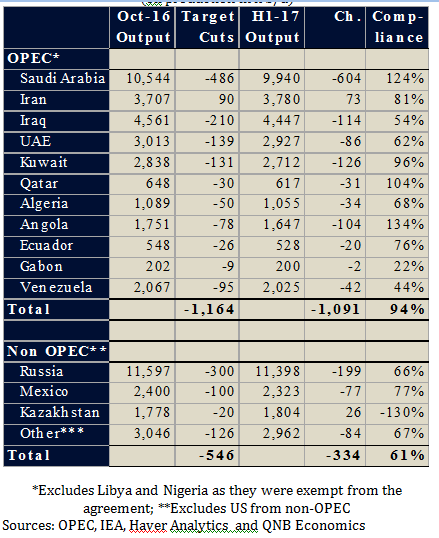Oil prices held up for most of the first half of 2017, averaging USD54/b up to the end of May following the agreement at the end of 2016 between OPEC and some major non-OPEC producers to restrict output. Prices then slumped to an average of USD48/b during June and July, mainly due to concerns about rising production in the US as well as increasing supply from Nigeria and Libya who were exempt from the OPEC agreement. However, towards the end of July, oil prices rebounded, rising 13% from a low of USD47/b earlier in the month to USD53/b at the end of the month. The recovery came despite an ongoing ramp up in US production and continued concerns about supply growth from Nigeria and Libya, raising the question, what was behind the recovery?
Two main drivers appear to have given a lift to oil prices. First, crude oil inventories, which had been rising persistently earlier in the year despite OPEC cuts, have begun to fall. In the US, crude oil inventories began to decline particularly rapidly in July and by more than expected. They fell by an average of 6.5m barrels each week compared with an average increase of 0.9m barrels during the first half of 2017.Although inventories usually fall at this time of year as it is the driving season in the US, they don’t usually fall by as much as this. The drawdown of inventories in the US has been enlarged by targeted OPEC efforts to cap exports. Saudi Arabia’s energy minister spoke about reducing exports to the US in May and at the end of July announced that total exports would be capped at 6.6m b/d. In the whole of the OECD, stocks are expected to fall from a peak of 3.02bn barrels in May to 2.99bn barrels by the end of the year.
Second, OPEC and some major non-OPEC producers stepped up efforts to enforce stricter compliance to the output cut agreement towards the end of July. OPEC compliance with the output cuts was 100% in Q1 but slipped slightly to 94% for the whole of the first half of 2017. Meanwhile, non-OPEC compliance has improved from 18% in Q1 to 61% for the year so far. This leaves room for improvement in compliance with the output cut agreement. On July 24th, the OPEC-non-OPEC monitoring committee stated that it would try to increase compliance with the output cuts. In the following days, a number of major producers, including the UAE and Kuwait affirmed their commitment to the agreement and said that they would make deeper cuts to their production. These statements gave a considerable boost to oil prices.
OPEC compliance with output cut agreement (oil production in k b/d)

Sources: OPEC, IEA, Haver Analytics and QNB Economics
What does this mean for our forecasts? So far this year, oil prices have averaged USD52/b. As expected, the rebalancing of the global oil market is well underway. The latest IEA data suggests that the market will be undersupplied by around 700k b/d in 2017 and 600k b/d in 2018, assuming that OPEC extends its output cuts for the full year in 2018. OPEC aims to reduce inventories to their historical five-year average, but we do not expect inventories to fall to that level by the end of the current agreement (March 2018). Therefore, OPEC will need to extend its output cuts to achieve its inventory objectives (see our recent commentary, OPEC’s 2018 dilemma). This should lead to considerably higher prices. However, US shale oil producers are likely to increase supply when prices rise above their cost breakeven levels. We, therefore, maintain our forecasts for prices to be capped at these breakeven levels, which we expect to average USD55/b in 2017 and USD58/b in 2018 (see our recent commentary, Is the fall in US shale breakeven prices over?).
